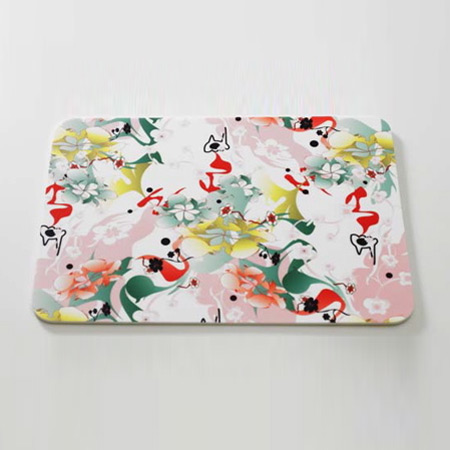
Corian: 40 Years - 40 Designers
DuPont, the manufacturer of Corian, has marked the composite material's 40th birthday by commissioning 40 designers to create products using the material.

A travelling exhibition of the products was first shown in Milan in April and will next be shown at Tent London at the Old Truman Brewery this September, during the London Design Festival.
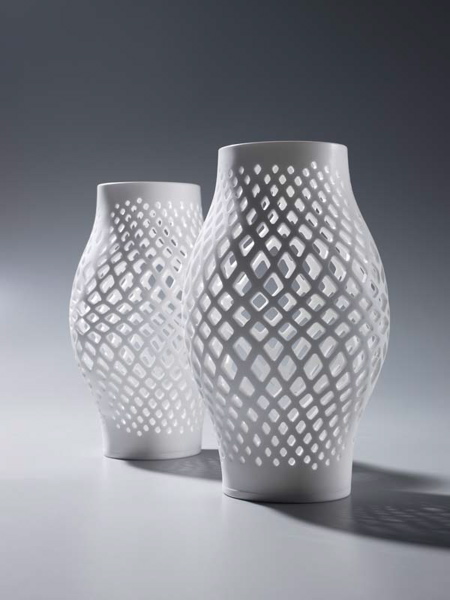
Top two images: Demons and Daisies by Katrin Olina Young; "A set of table place mats. This project gives attention to the graphic possibilities with Corian®. Here Corian® is used as a beautiful material support for graphics. The graphics feature two different elements often found in my expressive world: the darkness of Noc, the grinning ghost, and the dreaming of heavenly flowers."
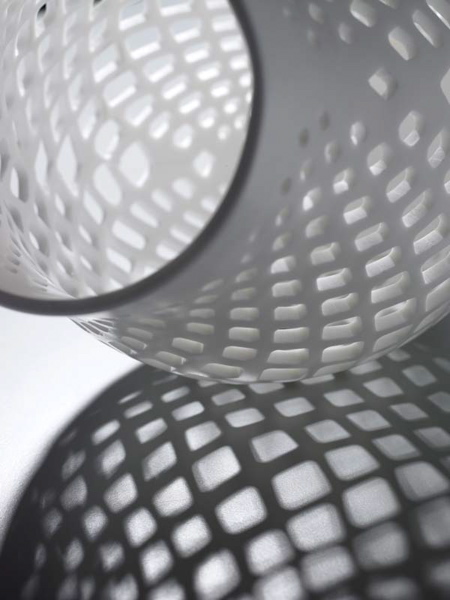
Above: Candelabra by Piers Mansfield-Scadden (Fly-Pitcher); "Inspired by the delicacy of paper lanterns and the intimacy of candlelight, this product combines the two in a piece of tableware exploring the translucency of Corian®. By slicing and cutting into the flat sheet with controlled insertions, beginning on the centre line, creating diamond patterns that progressively reduce in height as they move away from the horizon. Working out towards the top and bottom are equal diamond shapes stretching and opening up the shape from a flat sheet into a three-dimensional volume."
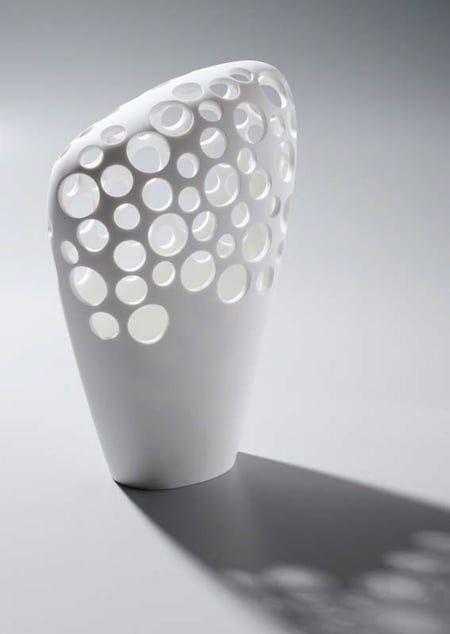
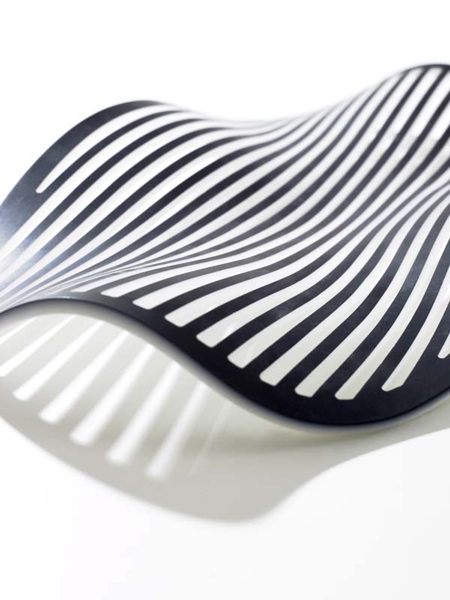
Above and below: Leaf by John Sebastian; "Inspired by a mono-material solution I wanted to define and elaborate the key attributes of Corian®. A close study pointed to three strong characteristics: strength, formability and lightness. These characteristics had to be expressed in the design, so that the object itself would best reflect the possibilities of Corian®. Using a new fabrication process in the making of this object was important, as it represents a new universe of possibilities with Corian®.
"I thought a permanent centrepiece for the table, a bowl or a tray, would be the right choice to exhibit the three distinctive characteristics. The result is iconic in nature: it stands out for its sculptural form and the beauty it adds to any table, like a jewel on a finger." Size: 270 x 460 x 60 mm
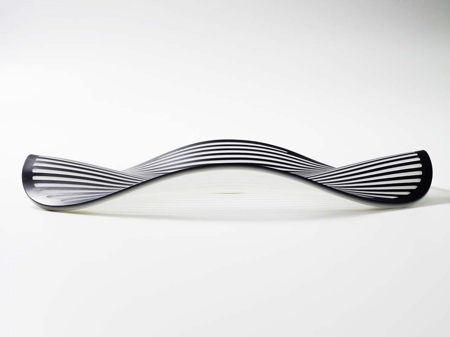
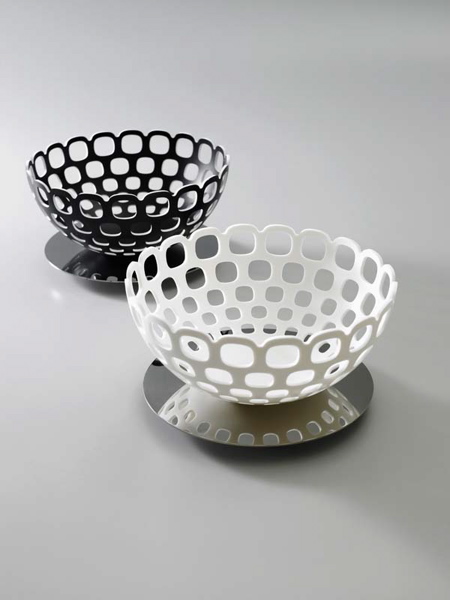
Above and below: Mirror by Luca Casini; "A wide base in bright steel reflects the hemisphere in perforated Corian®, suspending it ideally from the horizontal surface in a magical, static balance. A traditional fruit bowl artistically reinterpreted according to a contemporary eye, showcasing new geometries and proportions and a particular use of Corian®.
"The sheet of Corian® (in Glacier White colour) has been thermoformed and then painted black (matte effect); decorative holes have then been made, obtaining a layering effect of the chromatic tones visible through the thickness of the cut material. The white is emphasized between two very thin layers in black. Finally, the bowl has been fixed to the metal base."
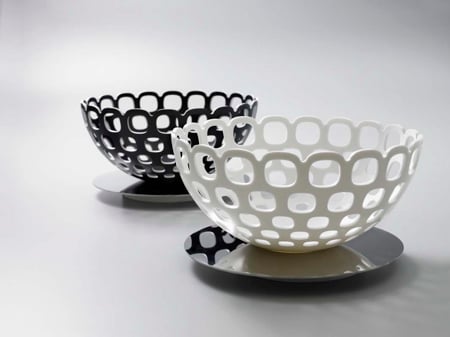
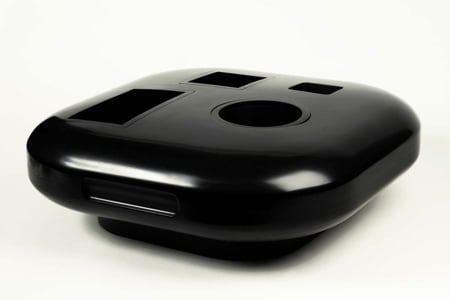
Above: Table Hub by Werner Aisslinger; "Table Hub is a multiuse table container in Corian® for all life situations: a flowerpot on dinner tables, a place for bottles or bread sticks during a party, a penholder or container for various electric adapters of laptops, cell phones on a work desk or the place for keys or MP3 player in an entrance situation of a flat.
"The elevated square shape with rounded edges and 4 different integrated sub-containers give freedom of choice for personalised use. The container also has an optional compartment which can hide a variety of objects out of sight, such as cables, books, magazines or cutlery.
"The Table Hub adheres to a functional design tradition, but is also an artistic and sculptural object with a strong personality and identity. The shape is organic with a simplicity that guarantees a long product life. The black shiny surface in Corian® makes Table Hub a new product typology with a distinguished sophisticated design." Size: about 550 x 550 mm, height 200 mm.

Above: Ark by Tanju Ozelgin; "This is a kind of bowl. The Ark bowls are based on double surfaces which can be used on both sides. The side lengths of the two surfaces are different from each other and are also very thin. It utilizes all the attributes of Corian®, and it is possible to have different colours for different faces.
"Being able to assemble the pieces makes it possible to respond to your real needs. For example, you can use only one of them to tidy up your office equipment like staples or pens on your desk, some of them to place your fruit, or a lot of them together in different combinations on your table in case of a feast. The number of configurations is almost infinite."
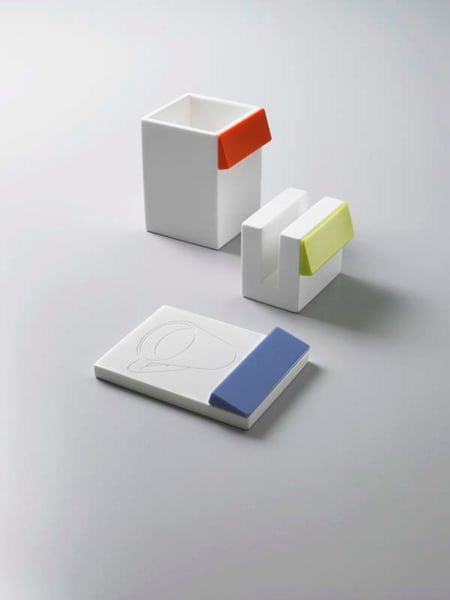
Above: Note friendly by Monika Kobiakov; a set of desk accessories comprised of a pen holder, a pad holder, and a mug mat. The key feature that unites the three uncomplicated elements is their added colour wedges designed for the convenient display of notes."

Above and below: Desert Core by Demet Bilici; "Desert Core desk pad meets the soft shades and shadows of the desert. To me, Corian® means prosperity, nobility, hygiene and a great variety of colours. Thus, when briefed to design a desk top functional item, I imagined a 'manager’s room', an area where all these aspects gather in great harmony.
"Desert Core lends deserved dignity to the manager’s office and plays a psychological role on the user, with its relaxing soft curves on the furthest end recalling the isolated, placid atmosphere of the desert. Manager desks deserve to be honoured by Desert Core."

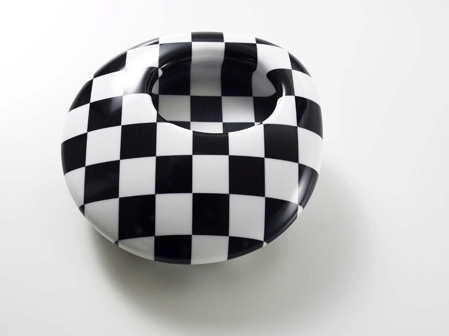

Below: Trottola by Nucleo (Piergiorgio Robino and Stefania Fersini); "Inspired by Muybridge's work (English-born photographer, known for his early use of multiple cameras to capture motion), the Trottola fruit bowl in Corian® is reminiscent of a spinning top, one of the oldest children's toys, frozen in four frames, combined to enhance the visual effect."
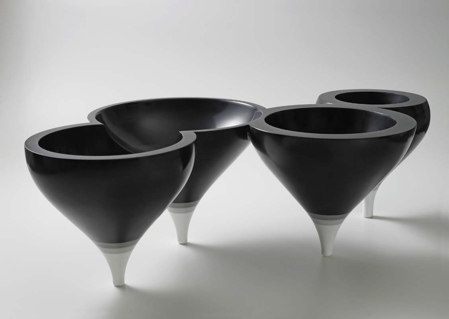
Below is an edited press release from Corian:
--
Corian®: 40 Years - 40 Designers
DuPont celebrates 40 years of the success of Corian®
through the multi-cultural creativity of 40 designers
June 2007 – To celebrate the 40th anniversary of DuPont™ Corian® solid surface material, DuPont presents “Corian®: 40 Years - 40 Designers", a travelling exhibition consisting of new creations by 40 designers (individual professionals, design studios or design teams) from around the world. After a first viewing in Milan, the event now comes to London to be shown at Tent London 20 -23 September 2007 at the Truman Brewery. “Corian®: 40 Years - 40 Designers" is a varied collection of new objects designed specially for this event and a selection of these objects will be produced in limited edition and commercialized.
In addition to marking the 40th anniversary of this extraordinary material, “Corian®: 40 Years - 40 Designers" aims to recognise and celebrate the huge contribution made by the design community to the way Corian® is perceived and used today
Each of the selected designers was challenged with creating a tabletop or desktop accessory, exploiting the special characteristics of Corian®. Seamless and highly formable using thermoforming or moulding techniques, Corian® can be routed and engraved using CNC machinery or printed using sublimation technology. It is available in 100 colours, including pure whites and vivid solid colours, and has a natural translucency in lighter hues, when backlit by natural or artificial light.
Corian®: 40 Years - 40 Designers" demonstrates - in microcosm - the virtually limitless possibilities of Corian® in both practical and aesthetic terms. The material has the ability to be almost anything… playful… businesslike… soothing… glamorous… ethereal...and at the same time, a simplicity and sensuousness that give it universal appeal. A truly multi-cultural material, Corian® is used in numerous different environments, in many countries across the world, which is reflected in the international nature of the 40 designers and in the diversity of the exhibited pieces. While objects had to have a specific function, they range from practical stacking trays to elegant centrepieces to quirky desk accessories such as puzzles and “worry stones".
Jean-Yves Bach, Regional Director of DuPont Corian® in Europe, Middle East and Africa, comments: “By looking at Corian® from new angles, designers have consistently pushed forward the boundaries of what it can achieve, and have in turn inspired others. The universality of Corian® today – used in homes, shops, restaurants, hotels, offices, airports, public spaces and hospitals, to name a few – owes much to the creativity of the designers who first believed in, and experimented with the material."